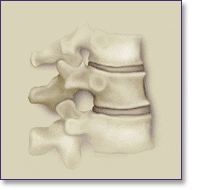Spinal fractures are quite common. In the United States alone, an estimated 700,000 spinal fractures occur each year. Although the majority of spinal fractures (also called vertebral compression fractures) are caused by osteoporosis, cancer and medical treatments such as chemotherapy can also weaken bone and increase the likelihood of fracture.
A spinal fracture occurs when one of the bones in the spinal column breaks. This type of fracture is also known as a vertebral compression fracture because the bone that breaks (the vertebral body) often cracks and collapses, becoming compressed.
About spinal fractures
The bones in your spinal column are different than the bones elsewhere in your skeleton. For example, the long bones in your legs are more rigid and dense than the square bones in your spine.
Strong, dense bone enables your legs to withstand rigorous movement. The vertebral bodies, however, are less dense and more “spongy,” to accommodate movements like bending and twisting. Because your vertebral bodies aren’t as strong as the bones in your legs, they can become more vulnerable to fracture.
Certain diseases, such as osteoporosis or cancer, are known to cause loss of bone mass and changes in bone structure, making them brittle and weak. Genetic factors and certain lifestyles, such as a low calcium diet, can also damage bone. Over time, the vertebral bodies can become so weak that normal activities such as bending over or lifting a bag of groceries, can cause a spinal fracture.
You can’t feel the changes in your bones while they are happening. In fact, many people are unaware that there is anything wrong until a fracture occurs.
Symptoms
Although you can’t feel your bones getting weaker, you might feel a spinal fracture when it occurs. Sudden and severe pain, out of proportion to the activity at hand, is a hallmark sign of a spinal fracture.
For most of us, the thought of breaking a bone during normal, non-strenuous activity is difficult to imagine. Many patients mistakenly attribute the pain of a spinal fracture to a muscle strain or “bad back.” Further complicating the issue is that spinal fractures often occur with only mild, or even indiscernible, pain.
Symptoms commonly associated with spinal fractures that are caused by osteoporosis or cancer include:
- Sudden onset of back pain, unrelated or out of proportion to activity
- Pain worsens with sitting or standing
- Pain is often relieved by lying down
If you have a spinal fracture that has not been diagnosed or has been treated without surgical intervention, be advised that the bone usually heals in its fractured position. This can alter the shape of your spine. For example, you or someone else may notice that:
- You are shorter than you used to be
- Your spine is curved forward (commonly called a dowager’s hump)
- Your clothing doesn’t fit properly
Baloon Kyphoplasty
 If you have been diagnosed with a spinal fracture caused by osteoporosis, cancer or benign tumors, balloon kyphoplasty is a treatment option you may want to consider. Balloon kyphoplasty is a minimally invasive procedure that can significantly reduce back pain and repair the broken bone of a spinal fracture.
If you have been diagnosed with a spinal fracture caused by osteoporosis, cancer or benign tumors, balloon kyphoplasty is a treatment option you may want to consider. Balloon kyphoplasty is a minimally invasive procedure that can significantly reduce back pain and repair the broken bone of a spinal fracture.
The procedure is called balloon kyphoplasty because orthopaedic balloons are used to lift the fractured bone and return it to the correct position.
Before the procedure, you will have a medical exam and undergo diagnostic studies such as X-rays, to determine the precise location of the fracture. Balloon kyphoplasty can be done under local or general anesthesia—your physician will decide which option is appropriate for you.
Balloon kyphoplasty takes about one hour per fracture treated. It can be done on an inpatient or outpatient basis, depending on medical necessity. After the procedure, you will likely be transferred to the Recovery Room for about an hour for observation.